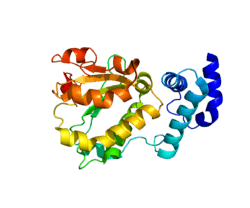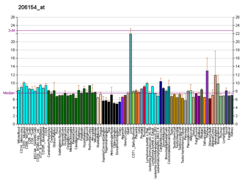Retinaldehyde-binding protein 1 is a protein that in humans is encoded by the RLBP1 gene.[5][6][7]
The protein encoded by this gene is a 36-kD water-soluble protein which carries 11-cis-retinaldehyde or 11-cis-retinal as physiologic ligands. It may be a functional component of the visual cycle. Mutations of this gene have been associated with severe rod-cone dystrophy, Bothnia dystrophy (nonsyndromic autosomal recessive retinitis pigmentosa) and retinitis punctata albescens.[7]
References
- 1 2 3 GRCh38: Ensembl release 89: ENSG00000140522 - Ensembl, May 2017
- 1 2 3 GRCm38: Ensembl release 89: ENSMUSG00000039194 - Ensembl, May 2017
- ↑ "Human PubMed Reference:".
- ↑ "Mouse PubMed Reference:".
- ↑ Sparkes RS, Heinzmann C, Goldflam S, Kojis T, Saari JC, Mohandas T, Klisak I, Bateman JB, Crabb JW (Mar 1992). "Assignment of the gene (RLBP1) for cellular retinaldehyde-binding protein (CRALBP) to human chromosome 15q26 and mouse chromosome 7". Genomics. 12 (1): 58–62. doi:10.1016/0888-7543(92)90406-I. PMID 1733864.
- ↑ Maw MA, Kennedy B, Knight A, Bridges R, Roth KE, Mani EJ, Mukkadan JK, Nancarrow D, Crabb JW, Denton MJ (Nov 1997). "Mutation of the gene encoding cellular retinaldehyde-binding protein in autosomal recessive retinitis pigmentosa". Nat Genet. 17 (2): 198–200. doi:10.1038/ng1097-198. PMID 9326942.
- 1 2 "Entrez Gene: RLBP1 retinaldehyde binding protein 1".
Further reading
- Crabb JW, Goldflam S, Harris SE, Saari JC (1989). "Cloning of the cDNAs encoding the cellular retinaldehyde-binding protein from bovine and human retina and comparison of the protein structures". J. Biol. Chem. 263 (35): 18688–92. PMID 3198595.
- Intres R, Goldflam S, Cook JR, Crabb JW (1994). "Molecular cloning and structural analysis of the human gene encoding cellular retinaldehyde-binding protein". J. Biol. Chem. 269 (41): 25411–8. PMID 7929238.
- Dunn KC, Aotaki-Keen AE, Putkey FR, Hjelmeland LM (1996). "ARPE-19, a human retinal pigment epithelial cell line with differentiated properties". Exp. Eye Res. 62 (2): 155–69. doi:10.1006/exer.1996.0020. PMID 8698076.
- Bonaldo MF, Lennon G, Soares MB (1997). "Normalization and subtraction: two approaches to facilitate gene discovery". Genome Res. 6 (9): 791–806. doi:10.1101/gr.6.9.791. PMID 8889548.
- Sarthy V (1997). "Cellular retinaldehyde-binding protein localization in cornea". Exp. Eye Res. 63 (6): 759–62. doi:10.1006/exer.1996.0170. PMID 9068383.
- Crabb JW, Carlson A, Chen Y, et al. (1998). "Structural and functional characterization of recombinant human cellular retinaldehyde-binding protein". Protein Sci. 7 (3): 746–57. doi:10.1002/pro.5560070324. PMC 2143945. PMID 9541407.
- Burstedt MS, Sandgren O, Holmgren G, Forsman-Semb K (1999). "Bothnia dystrophy caused by mutations in the cellular retinaldehyde-binding protein gene (RLBP1) on chromosome 15q26". Invest. Ophthalmol. Vis. Sci. 40 (5): 995–1000. PMID 10102298.
- Morimura H, Berson EL, Dryja TP (1999). "Recessive mutations in the RLBP1 gene encoding cellular retinaldehyde-binding protein in a form of retinitis punctata albescens". Invest. Ophthalmol. Vis. Sci. 40 (5): 1000–4. PMID 10102299.
- Thumann G, Kociok N, Bartz-Schmidt KU, et al. (2000). "Detection of mRNA for proteins involved in retinol metabolism in iris pigment epithelium". Graefes Arch. Clin. Exp. Ophthalmol. 237 (12): 1046–51. doi:10.1007/s004170050343. PMID 10654176.
- Burstedt MS, Forsman-Semb K, Golovleva I, et al. (2001). "Ocular phenotype of bothnia dystrophy, an autosomal recessive retinitis pigmentosa associated with an R234W mutation in the RLBP1 gene". Arch. Ophthalmol. 119 (2): 260–7. PMID 11176989.
- Harrington JJ, Sherf B, Rundlett S, et al. (2001). "Creation of genome-wide protein expression libraries using random activation of gene expression". Nat. Biotechnol. 19 (5): 440–5. doi:10.1038/88107. PMID 11329013.
- Katsanis N, Shroyer NF, Lewis RA, et al. (2001). "Fundus albipunctatus and retinitis punctata albescens in a pedigree with an R150Q mutation in RLBP1". Clin. Genet. 59 (6): 424–9. doi:10.1034/j.1399-0004.2001.590607.x. PMID 11453974.
- Eichers ER, Green JS, Stockton DW, et al. (2002). "Newfoundland rod-cone dystrophy, an early-onset retinal dystrophy, is caused by splice-junction mutations in RLBP1". Am. J. Hum. Genet. 70 (4): 955–64. doi:10.1086/339688. PMC 379124. PMID 11868161.
- Strausberg RL, Feingold EA, Grouse LH, et al. (2003). "Generation and initial analysis of more than 15,000 full-length human and mouse cDNA sequences". Proc. Natl. Acad. Sci. U.S.A. 99 (26): 16899–903. doi:10.1073/pnas.242603899. PMC 139241. PMID 12477932.
- Golovleva I, Bhattacharya S, Wu Z, et al. (2003). "Disease-causing mutations in the cellular retinaldehyde binding protein tighten and abolish ligand interactions". J. Biol. Chem. 278 (14): 12397–402. doi:10.1074/jbc.M207300200. PMID 12536144.
- Wu Z, Yang Y, Shaw N, et al. (2003). "Mapping the ligand binding pocket in the cellular retinaldehyde binding protein". J. Biol. Chem. 278 (14): 12390–6. doi:10.1074/jbc.M212775200. PMID 12536149.
- Fishman GA, Roberts MF, Derlacki DJ, et al. (2004). "Novel mutations in the cellular retinaldehyde-binding protein gene (RLBP1) associated with retinitis punctata albescens: evidence of interfamilial genetic heterogeneity and fundus changes in heterozygotes". Arch. Ophthalmol. 122 (1): 70–5. doi:10.1001/archopht.122.1.70. PMID 14718298.
- Nawrot M, West K, Huang J, et al. (2004). "Cellular retinaldehyde-binding protein interacts with ERM-binding phosphoprotein 50 in retinal pigment epithelium". Invest. Ophthalmol. Vis. Sci. 45 (2): 393–401. doi:10.1167/iovs.03-0989. PMID 14744877.





